
My dad was a birder. I always thought he looked silly, dressed up in his “bird outfit” and binoculars. And so I resisted the temptation, when I was a boy, to learn more about our feathered friends (Youthful rebellion at its most pointless). But then I became a seasonal ranger and suddenly scores of tourists on an hourly basis were seeking me out for ornithological advice. I did not want to fail them.
To be clear, I did know the difference between a Golden Eagle and a Turkey Vulture and could probably identify more species than I give myself credit for. But as I assumed my ranger responsibilities, my interest grew and it was helpful that I was surrounded by dedicated park birders who were more than happy to share their enthusiasm. Again, Ranger Kay Forsythe was my “go-to” person for bird knowledge. She was a walking bird encyclopedia.
One bird we both shared an affinity and affection for was the Raven. Perhaps we considered them underdogs who deserved so much more recognition than they ever received. Ravens still get no respect. Everyone wants to see an eagle. Nobody cares if they see a raven. It’s always been like this…
RAVENS RULE
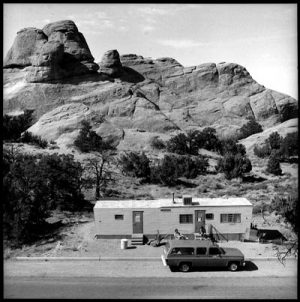
One warm summer night, years ago, I was collecting fees at the Devils Garden campground. We went site to site in those days, actually talking to the campers, and while it was a thankless job in some ways, (“We already paid at the gate…You mean we have to pay again?), there were some advantages to this kind of direct contact. On this particular evening, a woman from L.A. was about to invite me back for a Hibachi dinner, when I was called away by the gentleman in an adjoining site.
“Oh ranger,” I heard him call. “You’ve got to see this.” A pair of 7X50 binoculars bounced rhythmically off an ample abdomen as the camper from site 29 lumbered toward me.
“What seems to be the problem?” I asked. I always assumed there was a problem when tourists ran at me.
“No problem,” he explained. “But I think I just saw an eagle flying over there by that big arch.”
“No kidding,” I said. “Can you still see it?”
“Well, actually the wife spotted it first…Mother! Can you point out that eagle to the ranger?”
She left her dishes and joined us by the road.
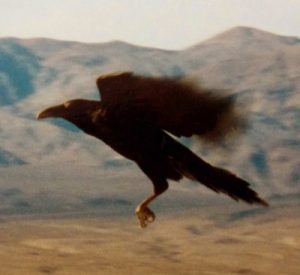
“Let me see…give me the binoculars, Harold…Yes! There it is!”
High above Skyline Arch I could see the dark soaring outline of the winged figure. It was a magnificent bird alright, but it wasn’t an eagle.
“That’s not an eagle, mam,” I said. “That’s a raven.”
“What? Give me those field glasses, Mother.” Harold was not convinced, but the binoculars gave him a sharper and closer view.
“Damn, mother…it’s just a big crow.”
“Now just a minute,” I said indignantly. “It’s not just a crow, and it’s not just a raven. It is one of the most intelligent, graceful, and fascinating birds you will ever hope to see. If I could come back to this life as any creature on Earth, I would return as a raven.”
Harold and Mother failed to be moved by my passionate defense of the raven.
“That’s fine, ranger…real interesting…Honey, do you need any help with the dishes?”
Sometimes spontaneous interpretive talks are an effective way to educate the public about the wonders of nature. This was not one of those times. I started to return to the woman from California with whom I hoped to share dinner, but was devastated to see that the guy from site 27 had moved in during my absence…the swine. I was left by myself, on the top of this sandstone fin by the campground road to contemplate the solitary raven and wonder if I should blame him for going hungry tonight.
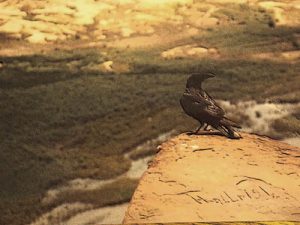
I have to admit, I wasn’t always a staunch defender of the Black Wonder. As a kid in Kentucky, my knowledge of ravens was limited to Edgar Alan Poe, and my grandfather regularly shot his BB gun at the cousin crows that inhabited our neck of the woods (The raven is mostly confined to the Western U.S., although they’re widely distributed over the northern hemisphere in Africa, Eurasia, Australia, and Central America.)
But on a trip, many years ago, to a remote section of the Grand Canyon, where the rim plunges more than 2000 feet to the Colorado River, I had my first opportunity to watch the remarkable acrobatic skills of the “Common” Raven. I’d never seen anything like it in my life.
Sometimes in groups of three or four, sometimes in pairs, sometimes alone, the incredible Corvus corax performed flying feats that I thought defied the laws of nature. In groups they engaged in furious dogfights and mutual pursuits. They plummeted into the canyon, their wings tucked in to reduce drag, and as they free-fell, they spiraled and spun in perfect harmony with the other. When they caught an updraft, they would reduce direction in a great swooping rush and ride the wind as high as they could go. When they sensed the apex of their ascent, the ravens arched over on their backs, and started the process all over again.
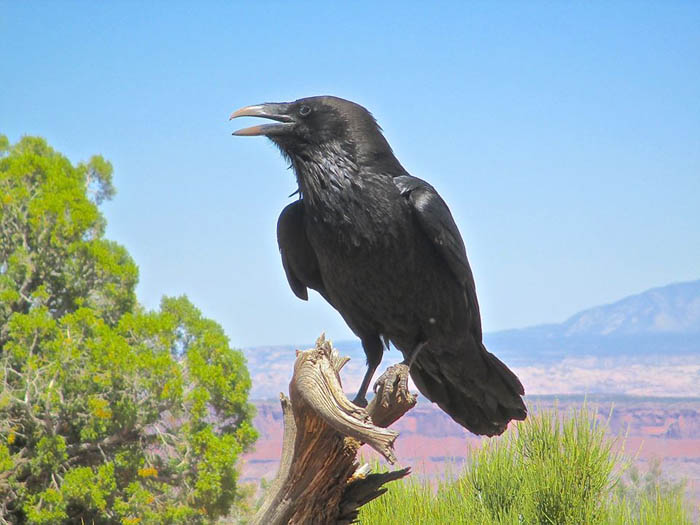
They kept this up for hours, flying and performing, it seemed, for the sheer joy of it. I never forgot the show and, later, as a park ranger, I felt it was my job, my duty, to speak in their defense. There is much to say in their defense too. As omnivores, ravens depend upon a wide variety of animal food, supplemented by some plants. They are also scavengers, taking advantage of carrion when it’s available (and keeping our highways clean, I might add).
Ravens are believed to mate for life, which is more than a lot of us can say, and some raven watchers report that both parents incubate the eggs (the males must be the apple of raven feminists everywhere). Ravens will fiercely defend their nest against intruders, whether they be raptors or humans. I once read of an incident in Oregon where some nosy ornithologists attempted to examine an active nest. Both parents left the nest when the group approached the nest. But as they were climbing down, the ravens returned. One of the ravens picked up rocks in its beak and hurled them down at the fleeing birdwatchers/annoyers.
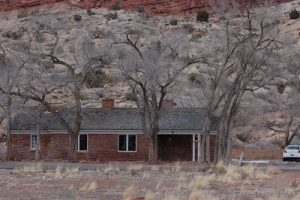
But to me, more than anything, these birds seem to have an extraordinarily refined sense of humor. Years ago, ravens built a nest on the cliffs above the Arches visitor center. When the young birds fledged the nest, they made a bee line for the front yard of the old rock house, then headquarters of the Canyonlands Natural History Association. All three fledglings and the parents congregated on the grassy lawn and awked and squawked and croaked the mornings away, much to the chagrin of the CNHA’s then-director and resident raven-hater, Eleanor Inskip.
Eleanor was a serious woman, and rarely appreciative of rebellious behavior that distracted from the more serious matters of the day. With all that senseless racket from the ravens, Inskip was unable to concentrate and, on several occasions, she charged out the door, fists clenched. With a face full of fury, she came after the ravens head-on. A few Inskip Charges and surely the ravens would surrender and find someone else to annoy. At least that’s what an over-confident Eleanor believed.
But she under-estimated her newest adversaries; after two or three days of being harassed by Ms. Inskip, it appeared she’d won. There was no sign or sound of the ravens. Then one afternoon, as the work day wound to a close, she and her staff locked up and headed for their respective cars. But they all stopped dead in their tracks.
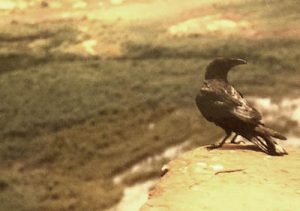
The ravens had not only surreptitiously come back, they’d left Eleanor a message. Many messages, in fact. From bow to stern, the Dark Avengers had shit all over Eleanor’s little Subaru. Badly. Windshield wipers were no help at all. Even more stunning was the realization that while there must have been five or six cars to choose from, the ravens had picked hers. And only hers. They must have staked out the driveway for a few days, no doubt keeping notes as they tried to determine vehicle ownership. I can almost imagine the ravenesque strategy at play…
“Okay…fellow birds of a black feather, after 72 hours of surveillance, I believe we can safely conclude that the hostile human female is the person who drives that little white car…Bert…do we know the make and model? Subaru Outback? The white one? Good…”
So let’s synchronize our internal clocks. The Hostile Female, according to our data, walks over to the park visitor center almost every afternoon, around 1500 hours. We will gather here at 1445 hours, and then you will wait for my signal. And please remember, we want this attack to be effective. So be sure to consume food products that will provide the ‘necessary explosive effect,’ if you know what I mean…”
(much awking and cawing follow)
It took a lot of paper towels and half a bottle of Windex to restore windshield visibility to the Subaru. And a trip to the car wash. Reluctantly acknowledging that she’d been outwitted, Eleanor Inskip surrendered. She ran up the white flag and bought a good set of ear plugs.
But the Arches ravens weren’t finished…

In 1983, when that much loathed and maligned Secretary of the Interior, James Watt came to visit the park, all the dirty tricks that Earth Firsters! and other ne’er-do-wells concocted, could not compare to the almost perfect aim of one raven named George.
Watt was not exactly sympathetic to a wilderness ethos and loved to antagonize environmentalists on a regular basis. Once asked to participate in a wilderness event, Watt explained, “I don’t like to walk, and I don’t like to paddle.” The environmental movement collectively recoiled in horror, but secretly loved the unleashed tongue of Mr. Watt. His more memorable rants made for perfect pre-social media memes that found their way to every fundraising letter, mailed by every non-profit green organization in America. Watt was indeed their sacred cow–he generated more money for the movement than Ewell Gibbons.
But back to George the Raven.
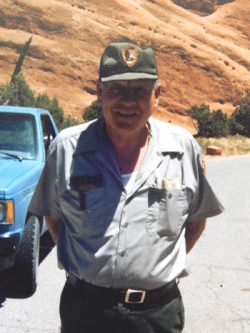
George was a shameless beggar who spent his days bumming food off tourists in and about the parking lot at Turret Arch. Sometimes, when handouts slowed, he’d flap his way over to Double Arch, to see if the pickin’s were better over there. Specifically he liked to hit on whatever the park maintenance man, Rocky Newell, cared to give him. I used to warn Rocky that feeding George was a violation of the Code of federal Regulations, but Rocky just laughed.
(for more on Rocky see: THE “ESSENTIALS” at ARCHES NP…DAVE BAKER, CARROLL CLARK, and ROCKY NEWELL (Ranger Stiles #9 1975-1986) …by Jim Stiles)
“James, my boy, George doesn’t take ‘no’ for an answer,” he explained. “It’s better to stay on George’s good side.” Besides Rocky, like George, was a rebel of sorts, who loathed rules and regulations and could see no reason why a tasty slice or two of Wonder Bread shouldn’t wind up in the beak of such an eager and enthusiastic recipient.
But George’s enthusiasm for Wonder Bread did not apparently extend to Jim Watt. I don’t know what Watt ever did to antagonize the raven (as far as I know CNN did not reach the Windows area of Arches in 1983), or if it was just a chance encounter, but as Secretary Watt walked across the Windows parking lot to his car after an exhausting 100 yard hike, Jim found himself a slowly moving target.
With a great flapping of wings, and an unearthly squawk, George took to the air. Ignoring a discarded apple core and a half-chewed piece of baloney, he headed straight for the shining bald pate of James Watt. At the appropriate moment, George released his white liquified incendiary bomb, and almost hit his mark. Close, but no cigar. The asphalt splattered at Watt’s feet and the secretary quickly put his Stetson back on for deflection purposes, in the event of a second wave attack. He stepped gingerly over the gooey mess and returned to his vehicle. But he kept glancing upward, half-crouched and with just a hint of fear in his eyes.
(‘Could it be? he may have wondered. ‘Are even the crows turning on me?’)
It was a monumental effort by the Great Black Bird, and what really matters is that he gave it his best shot. Watt left the park shortly thereafter, never returned to Arches, and a year later, resigned (some say in disgrace) as Interior secretary. Many firmly believe that George’s symbolic attack was the catalyst the country needed, the statement that had to be made, to confront James Watt, once and for all. But quietly, the treasurers of America’s mainstream environmental organizations shed a quiet tear. Contributions plummeted after Watt’s departure.
Today, as on any day, I can find a raven to watch. Whether they are performing aerial stunts, and going for maximum aerodynamic efficiency, or lazily flapping from one fin to the next, with their legs dangling freely beneath them, the fact that they are ignored and underrated by most bird watchers may bother me, but it doesn’t bother them…they couldn’t care less.
They’re too cool to care.
CAN A BIRD BE EVIL?
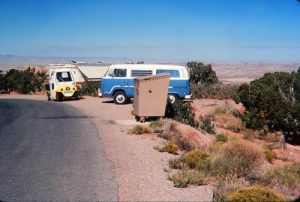
During the hot summer evenings at the Devils Garden, a lovely soothing sound often permeated the dry desert stillness and it’s difficult to describe. I thought it sounded like a gurgling water fountain or maybe a bubbling brook. Campers were often convinced it was the melody of some unknown woodwind instrument that a desert minstrel was playing out in the rocks.
In fact, it was a bird — the Brown-headed Cowbird to be precise. I had identified him using my Sibley guide, but as it turned out, the cowbird’s only redeeming feature was its song. Otherwise the molothrus ater is loathed far and wide. Even bird lovers hate them. Some even advocate their destruction. When I discovered why their reputation was so negative I was stunned.
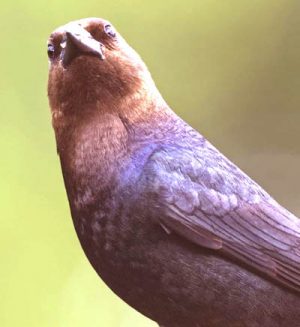
I thought only humans acted that badly.
Brown-headed Cowbirds are called “brood parasites.” The most euphemistic assessment of their behavior that I can find generously suggests that the cowbird “has a fascinating approach to raising its young.”
Fascinating indeed. Cowbirds don’t raise their young at all; instead they lay their eggs in the nests of other songbirds and let the host mothers hatch and raise them instead. If a female cowbird finds a nest with eggs in it already, she’ll push as many of the host eggs out, as needed, to make room for her own. Then she flies off to Vegas or somewhere.
Most of the host mother/victims never realize that they’re raising someone else’s nestling. Occasionally they’ll spot the intruder and peck it to pieces, but that’s rare. Instead the host mother dutifully tends what she thinks are her own eggs and then feeds them until they fledge.
And consider this. Cowbird eggs’ incubation period is often shorter than the eggs of the host. Consequently the cowbirds hatch sooner, giving them an opportunity to consume the lion’s share of the incoming food supply.
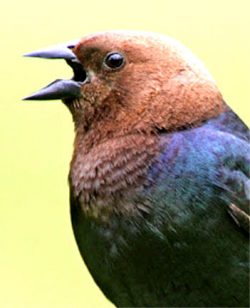
Cowbirds also develop faster than their step brothers and sisters and will even chuck other eggs from the nest, and even the other nestlings. Some juvenile cowbirds have been reported to smother them in the bottom of the nest!
If there was ever a need for serious contemplation of the Nature vs Nurture question, this is it. When a female cowbird reaches maturity, how does she know to perform the same dastardly deed as her mother? Since the “mother” (and I use the term loosely) was never around to teach her to begin with? How is that possible? And how does a just born brown-headed cowbird have the instinct to murder what it must assume to be its own brothers and sisters?
Troubling questions then and now. At least we can take some very cold comfort in knowing that other animal species are just as devious, conniving, cruel, and yes—evil—as humans can be. Though acknowledging such realities does not make me feel better about my own ill-tempered brothers and sisters. One thing for sure, if humans ever wipe ourselves out, and we’re replaced by the Brown-headed Cowbird, don’t expect conditions on Earth to get any better.
THE OWLS & the “SECRET SPRING”
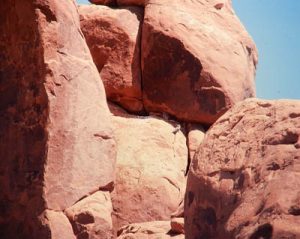
If the Brown-headed Cowbird is a selfish, miserable lout and a boor, we can take some comfort and solace as regards the Great Horned Owl. In Greek mythology, the owl was a symbol of Athena, the Greek Goddess of Wisdom. All these centuries later, that symbol has endured. To be considered “as wise as an owl,” is an ultimate tribute.
Like the Redtail Hawks I mentioned in the last installment, a family of Great Horned Owls made themselves at home on a high sandstone tower near the Devils Garden campground entrance for years. I first noticed the nest and the adults in the late 1970s and made sure to check daily (from afar) on their progress. Every year, the nestlings would eventually appear on the ledges, and I’d photograph them in various stages of development. From fluffy balls of downy white feathers, to creatures that almost, but not quite, resembled their parents, the Great Horned Young would move along the ledge, waiting for food, and then finally eager to find their own meals and to fledge the nest.
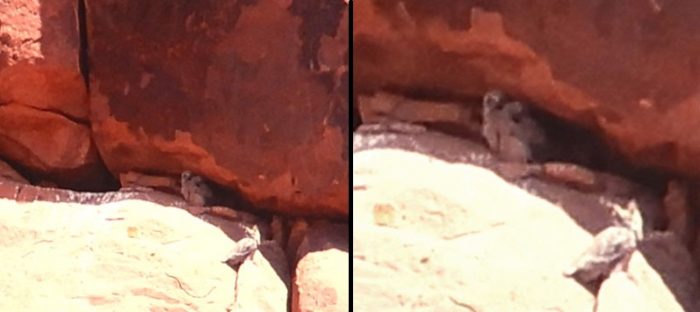
And there was always that day when I’d look up at the high tower and see the empty ledges and realize they were all gone. The owls had moved. But to where? It was only a consequence of my never-ending effort to escape the tourists that I found their hideout.
I freely admit that one Memorial Day weekend, I was shirking my duties and hiding as best I could from the throngs who had invaded the park. I had sought refuge on the old four wheel drive road that follows the spine of a ridge near the western edge of Salt Valley. From my vantage point on the rim, I could look across the valley to the Devils Garden and Fiery Furnace. The park road was bustling with activity–the moving glint and glare of reflected Winnebago motorhomes and Airstream trailers and yupstermobiles.
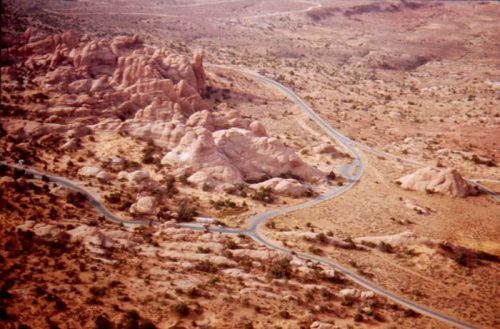
Unable to endure that scene any longer, I let my eyes fall to the valley itself, into the grey mancos badlands that dominate the south end of the confusing geology created by a collapsed salt dome, millions of years ago.
Within that moonscape, something caught my eye–it was an unnatural flash of green. I reached for my binoculars for a closer look and even from this distance, could make out several large cottonwood trees and what appeared to be a thicket of old tamarisk. I made a note of this anomaly and planned a visit there on my next scheduled backcountry day. The following week, I took my first exploratory hike to a place I’d never heard mentioned by the other rangers. What I found was an odd oasis in the desert.
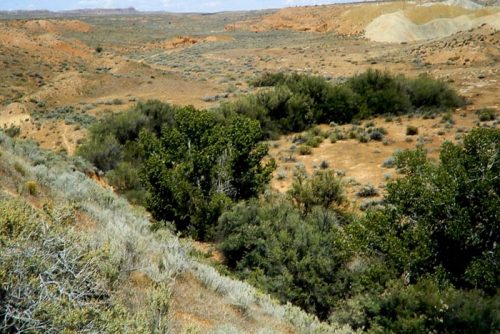
The sight of a spring fed patch of green is startling because it’s so unexpected. The hike to the spring winds through elephant backs of Mancos shale and there is no clue of the teeming life to be found until that last turn of the wash. I emerged from the badlands near the oasis’s southern end and began walking upstream beneath a canopy of tamarisk. Unlike the thickets I was accustomed to along the Colorado, many of these trees were a foot thick–-and there was little evidence of new growth. The floor of the wash began to appear damp and eventually a trickle of water appeared over the sand. Near the north end of the oasis, several mature cottonwoods grew by the wash. Just beyond them, I discovered a pool of water, hidden in the shade of some tammies. Beyond this point, the desert reclaimed the land.
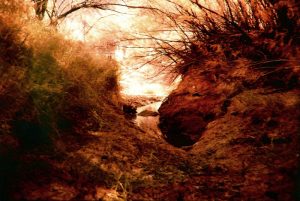
The pool was insignificant by most standards; it was no more than a foot deep, three feet wide, and perhaps eight feet long. But for the next ten years, that pool was always there and it provided water to a variety of animals. From here, it was at least three miles to the nearest permanent water.
What I discovered at the spring in the weeks and months and years ahead was a diversity of wildlife that was unmatched anywhere else in the park. It became a place that I loved to escape to. And it was here, in early summer, that I found the owls.
On that particular morning, I had hiked down from the park road to check on a Cooper’s Hawk nest. Sturdily constructed into the branches of the grandest of the cottonwood trees, I had first spotted the nest on an earlier visit. Now I was gazing into those lucent green leaves when I realized something was looking back. It wasn’t a Cooper’s Hawk. It was a very young fledged owl. He didn’t move—didn’t even blink. I had time to raise my camera and take a couple of photos. Then, suddenly another immature GHO broke from the branches and flew to a mound of Mancos Shale, just 100 feet away. I saw another owl clinging precariously to the tops of a tamarisk tree. Then I spotted another. And another. At one point I counted three immatures and two adults. Then it hit me–this must be the family that left their nest at the Devils Garden just a week or so ago.
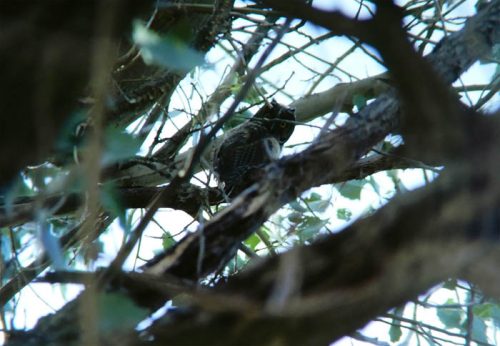
I decided to leave them in peace; after all I’d come here to escape the crowds and for all I knew, they may have come here to escape from me (“Look, Al..it’s that damn ranger again with his binoculars.”). But I did return on a couple occasions each summer and fall, just to check on things.
The Cooper’s Hawk nest was occupied every spring for a decade. Deer and coyotes regularly visited the spring. I saw or noted the sign of kit fox and ringtail cats. And there were the owls. It was, in effect, a meeting place for Life in an otherwise very inhospitable location. As the summer wore on, the flowing water stopped and the pool shrank, but it never disappeared. Even in September, standing water, shaded by the tammies, had survived the intense desert heat.

I wondered if I should tell anyone about this magical spot. I hesitated for two reasons—first, even then, I knew that identifying “secret places” could have a devastating effect. Too many well-intentioned admirers can spoil just about anything. Second, I realized that “beauty is often in the eye of the beholder.” A dedicated tamarisk hater would only want to tear it down. In this case, I thought tammie eradication could do more harm than good. So I proclaimed my discovery the “Secret Spring” and decided to keep it mostly to myself. In ten years I revealed the Secret Spring to two of my fellow rangers. While neither of them was a fan of exotic plants, both agreed–the best way to protect this area was by leaving it alone and for a decade, it stayed that way.
And then it was gone.
NEXT TIME: The demise of the Secret Spring.
Jim Stiles is Founding Publisher and Senior Editor of the Canyon Country Zephyr.
Click Here to read the previous installments of Ranger Stiles’ Wildlife Observation Notes…
To comment, scroll to the bottom of the page.
Zephyr Policy: REAL NAMES ONLY on Comments!
Don’t forget the Zephyr ads! All links are hot!

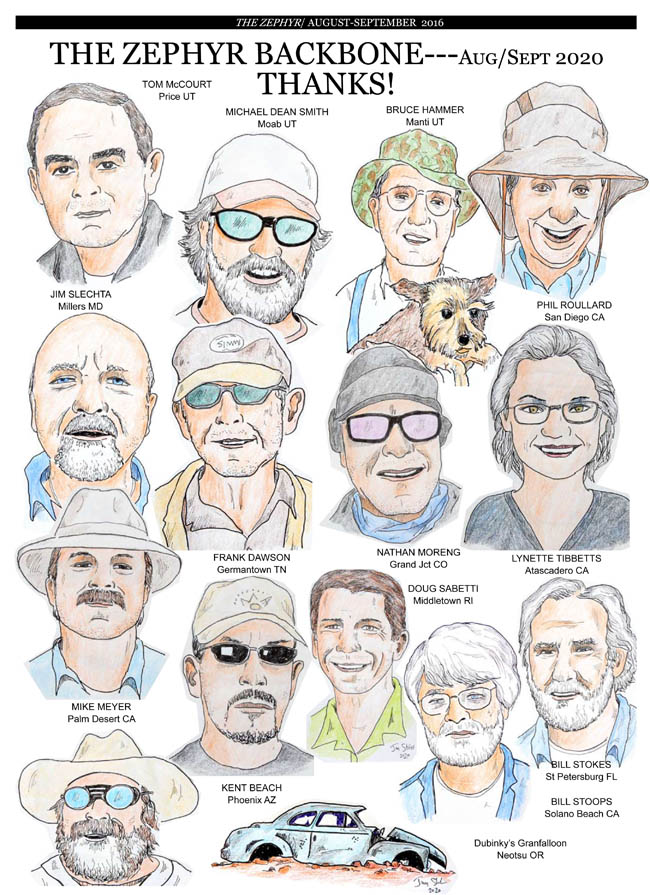








I loved the owls and their Secret Spring. Thank you for keeping it that way … for a while. I had the great pleasure to have a GHO hang around my little acre for about a week or so until a territorial pair of scrub jays harassed it and it flew away. Hawks and even a Golden Eagle have followed in using our Chinese elms for shelter. They helped drive the bunnies underground … for a while.
Ravens have always been a favorite of mine. What other bird seems to have so much fun flying? Many years ago we went to Haida Gwaii in British Columbia, formerly known as The Queen Charlotte Islands. We were the sole campers in a primitive campground on the ocean. To the Haida people the raven is a trickster spirit, and he let human beings into this world by tapping on the clam shell that they were trapped in. We were awakened by a tapping and clicking on the roof of our VW van; it turned out to be a raven, marching up and down, apparently freeing us from our clam shell, with plans for breakfast from us. He didn’t get it because I have a policy about feeding wild animals. This early morning wake-up call continued every morning for the three days we were there. I’m beginning to see we were lucky that the raven didn’t hold a grudge.
Whether you are a recreational river runner or an old river guide like me, if you spent much time on the rivers out here you probably have a story or two about these smart birds; all of which have their own buttons to push and/or sense of humor when it comes to us humans. I have stories regarding my own experiences with Ravens, Redtails, Peregrines and Golden Eagles (all at the same time, but too long to explain here). But thought of two situations about “Raidin’ River Ravens” to share.
So I’m on a Cataract Canyon trip and pulled in for camp; unloaded boats and passengers spread quickly to nail down a camp spot; I threw my day pack down behind a tamarisk to claim my spot, then proceeded to help set up camp kitchen, and was in middle of slice-and-dice time for supper when I saw this raven that had been circling camp fly right over me, with my wallet in his beak! I forget if it was a tomato or a potato I was working on, but I threw it as fast and as hard as I could and got close enough that Mister Raven dropped my wallet in wet sand only a foot or so from river’s edge. I scampered down to reclaim my ID & cards before they floated away, angry at myself about my forgetfulness about zipping my pack. “Damn raven,” I scoffed. Just about then, a lady in our group came running into kitchen screaming and pointing at her camp spot. We rushed back to her spot to find that this same raven had found her private stash of trail mix goodies she had in a baggie and this same old bird (probably?) had torn into it and flung nuts, seeds, berries and whatever else to hither and yon, and had done a pretty good job pullin’ apart her backpack. Beware the Raven….
Another time, on a runout on a lower San Juan River trip; as I passed by several unattended boats parked at the mouth of Oljeto Wash, I saw a raven party in full swing. The novice boaters (experience teaches you to carry trash under the baggage, not on top) had left a big black bag of garbage on top of their duffel pile, and these four ravens were having the time of their life tearing into the bag and had tossed trash & wet garbage making a gawdawful mess. The apparent “prize” was a couple of bagels that they were fighting over, and none of them could quite get control and airborne without the others thrashing the one with the bagel. I floated past, thinking of my near miss with the purloined wallet from prior years’ experience. Damn I love these guys. Smart as can be…tricksters? or shape-shifters maybe?
Thanks for your stories Jim; they always jog me noggin’ about the good ole days.
Cowbirds – are they just Cuckoo?
Ravens: flying Marmots. Those two animals have provided me more entertainment in the wilderness than anything else. I am greatly endebted to them for their anthropomorphic qualities as they embody a lot of those qualities we wished we had more of.
I really enjoyed your story…How awesome that you were able to experience such great wonderland..thank you for sharing..cant wait until next month